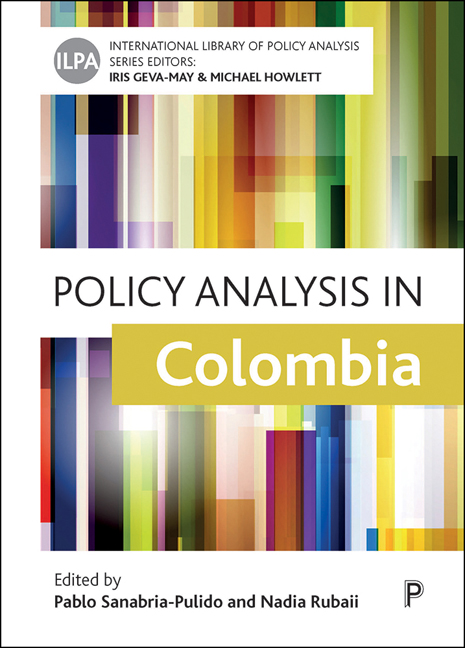Book contents
- Frontmatter
- Dedication
- Contents
- List of Figures and Tables
- List of Abbreviations
- Notes on Contributors
- Editors’ Introduction to the Series
- Policy Analysis in Colombia: An Introduction
- Part One Policy Analysis in Contemporary Colombia
- One The policy Analysis Movement in Colombia: The State of the Art
- Two Evolution of Policy Analysis as a Field of Study and Instruction in Colombia
- Three Policy Analysis, Bureaucratic Capacity and Public Administration Reforms in Colombia
- Part Two Policy Analysis within National and Subnational Governments
- Four Policy Analysis Inside Central Government in Colombia
- Five Policy Analysis and the Legislature in Colombia
- Six Policy Analysis in the Colombian Constitutional Court
- Seven Metropolitan Governance and Policy Analysis in Colombia
- Eight Policy Analysis for Decision Making in Colombian Local Governments
- Part Three Policy Analysis in Key Policy Domains
- Nine Policy Analysis in the Education Sector in Colombia
- Ten Policy Analysis in the Health Sector in Colombia
- Eleven Policy Analysis and Decision Making in the Military Forces: The Havana Experience
- Twelve Technocracy, Decision Making and Economic Policy in Colombia
- Thirteen Social Policy, Target Populations and Policy Analysis in Colombia
- Part Four Policy Analysis Beyond the State
- Fourteen Political Parties and Policy Analysis in Colombia
- Fifteen Policy Analysis and NGOs in Colombia
- Sixteen Media, Evidence and Policy Analysis in Colombia
- Conclusion: Building Capacity for Policy Analysis Amid Tensions and Challenges in Colombia
- Index
Eleven - Policy Analysis and Decision Making in the Military Forces: The Havana Experience
Published online by Cambridge University Press: 10 March 2021
- Frontmatter
- Dedication
- Contents
- List of Figures and Tables
- List of Abbreviations
- Notes on Contributors
- Editors’ Introduction to the Series
- Policy Analysis in Colombia: An Introduction
- Part One Policy Analysis in Contemporary Colombia
- One The policy Analysis Movement in Colombia: The State of the Art
- Two Evolution of Policy Analysis as a Field of Study and Instruction in Colombia
- Three Policy Analysis, Bureaucratic Capacity and Public Administration Reforms in Colombia
- Part Two Policy Analysis within National and Subnational Governments
- Four Policy Analysis Inside Central Government in Colombia
- Five Policy Analysis and the Legislature in Colombia
- Six Policy Analysis in the Colombian Constitutional Court
- Seven Metropolitan Governance and Policy Analysis in Colombia
- Eight Policy Analysis for Decision Making in Colombian Local Governments
- Part Three Policy Analysis in Key Policy Domains
- Nine Policy Analysis in the Education Sector in Colombia
- Ten Policy Analysis in the Health Sector in Colombia
- Eleven Policy Analysis and Decision Making in the Military Forces: The Havana Experience
- Twelve Technocracy, Decision Making and Economic Policy in Colombia
- Thirteen Social Policy, Target Populations and Policy Analysis in Colombia
- Part Four Policy Analysis Beyond the State
- Fourteen Political Parties and Policy Analysis in Colombia
- Fifteen Policy Analysis and NGOs in Colombia
- Sixteen Media, Evidence and Policy Analysis in Colombia
- Conclusion: Building Capacity for Policy Analysis Amid Tensions and Challenges in Colombia
- Index
Summary
Introduction
In late August 2012, the National Government of Colombia and the guerilla group FARC-EP signed a general agreement to engage in formal negotiations that would end the longest-running conflict in the western hemisphere. According to the Office of the High Commissioner for Peace, the agreement set forth a roadmap with three main objectives: to end the Colombian armed conflict, to establish the conditions for maintaining negotiations between the two parties, and to agree on the rules of the game during the negotiation process (2018). The negotiation agenda for the talks in Havana, Cuba would be divided into six main points: comprehensive rural reform; political participation; end of the conflict; solution to the problem of illicit drugs; rights of victims; and implementation, verification and ratification.
Before defining each of these points, the interests and motivations of the conflict parties, their perception of conflict and their internal decision-making processes had to be analyzed to explore viable solutions and align policies relevant to these issues (Conciliation Resources, 2009). Additionally, these aspects were to be negotiated separately, but would not be considered agreed until the full agreement was finalized. As President Juan Manuel Santos’ motto indicated during the negotiation, “nothing is agreed upon until everything is agreed upon”, a common rule in negotiations (Herbolzheimer, 2016).
In Havana, it was agreed that the principles, actions, and future of the Armed Forces would not be discussed. Likewise, the negotiations would proceed without a ceasefire agreement in place between the parties; therefore, combat operations would continue until a definitive ceasefire was reached. Even if the role of the military was not open for discussion, and military activities were not terminated, the role of the military was crucial in supporting and eventually implementing key components of the agreement. Active military and police officers were appointed as advisors to the negotiations, with the objective of creating an atmosphere of trust within the Armed Forces for whatever final deal would result. Within this context, the Strategic Command for Transition (Comando Estratégico para la Transición – COET) was created, to be chaired by General Javier Flórez of the Colombian National Army.
- Type
- Chapter
- Information
- Policy Analysis in Colombia , pp. 187 - 202Publisher: Bristol University PressPrint publication year: 2020



